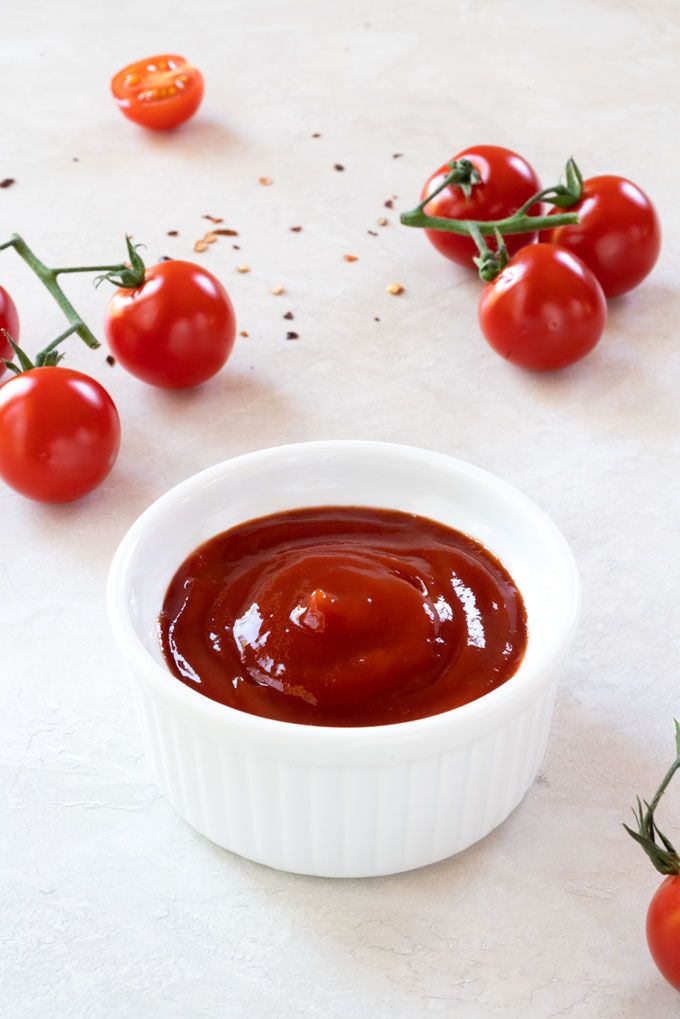Tomato ketchup is one of the most popular condiments around the world. Whether you’re enjoying crispy fries, burgers, or even pakoras, ketchup always adds a delightful tangy flavor. While store-bought ketchup is convenient, homemade tomato ketchup is in a league of its own, bursting with freshness and free from preservatives.
In this recipe, we’ll show you how to make tomato ketchup at home with a handful of simple ingredients. Not only is this recipe easy to follow, but it also allows you to adjust the sweetness, tanginess, and spice level to suit your taste.

Ingredients
- 2 kg ripe tomatoes (preferably Roma or plum tomatoes)
- 1 large onion, finely chopped
- 4-5 cloves garlic, minced
- 1-inch piece of ginger, grated
- 1/2 cup sugar (adjust to taste)
- 1/2 cup white vinegar (adjust to taste)
- 1 tsp salt (adjust to taste)
- 1 tsp black pepper powder
- 1 tsp ground cumin (optional)
- 1/2 tsp paprika or red chili powder (for a mild kick)
- 2 cloves
- 1 bay leaf
- 1 cinnamon stick
- 1/2 tsp mustard seeds (optional)
- 1 tbsp olive oil (or vegetable oil)
Preparation Steps
Step 1: Preparing the Tomatoes
The base of a great ketchup starts with fresh, ripe tomatoes. Choose firm, bright-red tomatoes that are free from blemishes.
- Wash the tomatoes thoroughly under running water.
- Cut the tomatoes into quarters. Remove the green stem part if necessary.
- You don’t need to peel the tomatoes as they will be blended and strained later.
Step 2: Cook the Tomatoes
Cooking the tomatoes with a blend of spices is essential to develop the deep, rich flavor of ketchup.
- In a large pot, heat the oil over medium heat. Add the chopped onions, garlic, and ginger.
- Sauté for about 3-4 minutes until the onions turn translucent and the garlic and ginger are fragrant.
- Add the quartered tomatoes, cloves, bay leaf, and cinnamon stick. Stir well to combine.
- Cover the pot and let the tomatoes cook on medium heat for 25-30 minutes. Stir occasionally to ensure nothing sticks to the bottom.
- As the tomatoes cook, they will release their juices and soften. If needed, add a small amount of water to prevent the mixture from drying out.
Step 3: Blend and Strain the Tomato Mixture
Once the tomatoes have softened and broken down, it’s time to blend them into a smooth paste.
- Remove the bay leaf, cinnamon stick, and cloves from the mixture.
- Use an immersion blender or a regular blender to blend the tomato mixture until smooth.
- Strain the blended mixture through a fine-mesh sieve to remove any seeds or tomato skin, ensuring a silky-smooth ketchup.
Step 4: Seasoning and Flavoring
Now it’s time to add the signature ketchup flavors of sweetness, tanginess, and a hint of spice.
- Return the strained tomato puree to the pot.
- Add sugar, vinegar, salt, black pepper, paprika (or red chili powder), and ground cumin (if using).
- Stir everything together and taste the mixture. Adjust the sugar or vinegar to your preference. If you like your ketchup sweeter, add a bit more sugar; if you prefer a tangier version, increase the vinegar.
Step 5: Reduce the Ketchup
The key to thick, luscious ketchup is reducing the tomato mixture until it reaches the desired consistency.
- Bring the mixture to a gentle simmer over low heat.
- Let the ketchup cook for about 30-40 minutes, stirring occasionally to prevent sticking.
- The ketchup will gradually thicken as the excess moisture evaporates. Keep an eye on the consistency — it should be thick enough to coat the back of a spoon.
Step 6: Final Adjustments and Bottling
Once the ketchup has reached your preferred consistency, it’s time to make any final adjustments before bottling.
- Taste the ketchup and adjust the seasoning if necessary. Add more salt, sugar, or vinegar to balance the flavors.
- Once you’re satisfied with the taste and consistency, let the ketchup cool down slightly.
To store your homemade ketchup:
- Sterilize glass bottles or jars by boiling them in water for 10 minutes. This helps increase the shelf life of the ketchup.
- Pour the warm ketchup into the sterilized bottles or jars, leaving a little space at the top.
- Seal the bottles tightly and let them cool at room temperature. Once cooled, refrigerate the ketchup.
Storage and Shelf Life
Homemade ketchup can last for up to 2-3 weeks in the refrigerator. The vinegar and sugar act as natural preservatives, but since it doesn’t contain any artificial preservatives, it’s best to consume it within this time frame.
For longer storage:
- You can freeze the ketchup in small batches using airtight containers or ice cube trays. Frozen ketchup can last for up to 3 months.
Tips for Perfect Homemade Ketchup
- Use Ripe Tomatoes: The ripeness of your tomatoes will directly impact the flavor of your ketchup. The riper and juicier the tomatoes, the richer your ketchup will taste.
- Adjust to Your Taste: Feel free to modify the sweetness, tanginess, and spice levels to suit your preferences. Some like their ketchup on the sweeter side, while others prefer it tangy and spicy.
- Strain the Ketchup: Straining the tomato mixture ensures a smooth, lump-free ketchup. Don’t skip this step for a perfect texture.
- Sterilize Your Bottles: Sterilizing the storage jars or bottles increases the shelf life of your homemade ketchup.
- Slow Cooking for Flavor: Letting the tomato mixture simmer slowly is the key to developing deep, complex flavors. Don’t rush this step!
Conclusion
Making your own tomato ketchup at home is a rewarding process. It not only allows you to control the ingredients and flavors but also gives you a preservative-free alternative to store-bought varieties. The fresh, tangy-sweet flavor of homemade ketchup is far superior, and once you try it, you may never go back to the bottled version.
Pair it with fries, sandwiches, burgers, or anything else you love, and enjoy the unbeatable taste of fresh, homemade ketchup!

